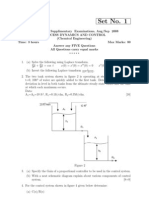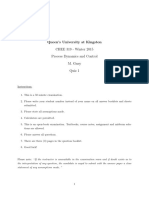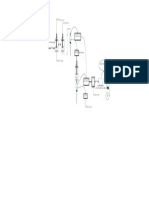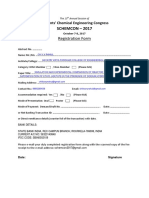APC c1-20
Uploaded by
rahulAPC c1-20
Uploaded by
rahulNATIONAL INSTITUTE OF TECHNOLOGY, TIRUCHIRAPPALLI - 620 015
M.TECH. DEGREE I SEMESTER, I CYCLE TEST
BRANCH: CHEMICAL ENGINEERING
SUB. CODE & TITLE: CL601 ADVANCED PROCESS CONTROL
DATE: 09-11-2020 TIME: 04.00 a.m. To 05.00 a.m. MAX. MARKS: 25
ANSWER ALL QUESTIONS
1. Find the response of the following system to a unit step input. Tabulate and sketch the
response.
y(s) (−3s + 1)(− s + 1)
= .
x( s) (2s + 1)(4s + 1)(5s + 1)
2. The two tanks shown in figure are connected in an interacting fashion. The system is
initially at steady state with q = 10 cfm. The following data apply to the tanks: A1 =
1ft2, A2 = 1.25 ft2, R1 = 1 ft/cfm and R2 = 0.8 ft/cfm.
a. If the flow changes from 10 to 11 cfm according to a step change, determine H2(s),
i.e. the Laplace transform of H2(t), where H2 is the deviation in h2.
b. Determine H2(1), H2(4), H2(∞).
c. Determine the initial levels (actual levels) h1(0) and h2(0) in the tanks.
d. Obtain an expression for H1(s) for the unit-step change described above.
3. A single-tank process has been operating for a long period of
time with the inlet flow rate qi equal to 30.4 ft3/min. After the
operator increases the flow rate suddenly at t = 0 by 10%, the
liquid level in the tank changes as shown in Table. Assuming
that the process dynamics can be described by a first-order
model, calculate the steady-state gain and the time constant
using any two methods
4. For the control system shown in Figure, determine
a) C(S)/R(s) b) C(∞) c) Offset d) C(0.5) e) Whether closed loop response is
oscillatory?
5. Draw the Nyquist diagram for the process G(s)=4/(2s+1)(4s+1). Determine the
proportional gain that can be used.
•••••
You might also like
- Notes:: National Exams May 2016 04-Chcm-A6, Process Control 3 Hours DurationNo ratings yetNotes:: National Exams May 2016 04-Chcm-A6, Process Control 3 Hours Duration9 pages
- Branch: Chemical Engineering Date: 01.03.2022 Time: 09.00 AM To 10.00 AM Max. Marks: 25 Sub. Code & Title: Clpc2 4 Process Dynamics & ControlNo ratings yetBranch: Chemical Engineering Date: 01.03.2022 Time: 09.00 AM To 10.00 AM Max. Marks: 25 Sub. Code & Title: Clpc2 4 Process Dynamics & Control2 pages
- H, Should Be Maintained at Their Respective Desired Operating Conditions. The Variables Q, T and PNo ratings yetH, Should Be Maintained at Their Respective Desired Operating Conditions. The Variables Q, T and P3 pages
- CHEN3005 Process Instrumentation and ControlNo ratings yetCHEN3005 Process Instrumentation and Control4 pages
- F 0.085m3 Imin V 2.1m3. The Reaetor Has Been Operating Around A Steady CA/-i, Ss 0.925 MoleNo ratings yetF 0.085m3 Imin V 2.1m3. The Reaetor Has Been Operating Around A Steady CA/-i, Ss 0.925 Mole6 pages
- Process Control and Instrumentation: B. Tech. Seventh Semester (Chemical Engineering) (C.B.S.)No ratings yetProcess Control and Instrumentation: B. Tech. Seventh Semester (Chemical Engineering) (C.B.S.)2 pages
- Bkf3413 Process Control & Dynamics 11617No ratings yetBkf3413 Process Control & Dynamics 116175 pages
- Homework 4: X =μ∗X−D∗X S= μ∗X Y D∗ (S S)No ratings yetHomework 4: X =μ∗X−D∗X S= μ∗X Y D∗ (S S)7 pages
- Analytical Modeling of Solute Transport in Groundwater: Using Models to Understand the Effect of Natural Processes on Contaminant Fate and TransportFrom EverandAnalytical Modeling of Solute Transport in Groundwater: Using Models to Understand the Effect of Natural Processes on Contaminant Fate and TransportNo ratings yet
- Best and Last Rank Details 16-17 PortraitNo ratings yetBest and Last Rank Details 16-17 Portrait1 page
- Chemical Engineering & Process TechnologyNo ratings yetChemical Engineering & Process Technology8 pages
- Tara Gum - A Safe and Natural Biopolymer: AbstractNo ratings yetTara Gum - A Safe and Natural Biopolymer: Abstract1 page
- Modelling and Simulation of Saponification Reaction in Different Type of ReactorNo ratings yetModelling and Simulation of Saponification Reaction in Different Type of Reactor9 pages
- Chemical Plant Design and Economics - R2009 - 29!05!2014No ratings yetChemical Plant Design and Economics - R2009 - 29!05!20142 pages
- Matlab 1. 2. 3. 4. Aspen Hysys and Plus 1. 2. 3. 4. 5. 6. Chemcad 1. 2No ratings yetMatlab 1. 2. 3. 4. Aspen Hysys and Plus 1. 2. 3. 4. 5. 6. Chemcad 1. 21 page
- Chemical Plant Design and Economics - R2009 - 11!12!2012No ratings yetChemical Plant Design and Economics - R2009 - 11!12!20121 page
- Ach - 1115 - Chemical Reaction Engineering-I, 29-05-2013, May-2013No ratings yetAch - 1115 - Chemical Reaction Engineering-I, 29-05-2013, May-20132 pages
- Chemical Plant Design and Economics - R2009 - 20!05!2013No ratings yetChemical Plant Design and Economics - R2009 - 20!05!20132 pages
- Industrial Pollution and Control - R2009 - 24!11!2014No ratings yetIndustrial Pollution and Control - R2009 - 24!11!20141 page
- Mathemagics: Academy of Vedic Mathematics Introductory CourseNo ratings yetMathemagics: Academy of Vedic Mathematics Introductory Course5 pages















































































